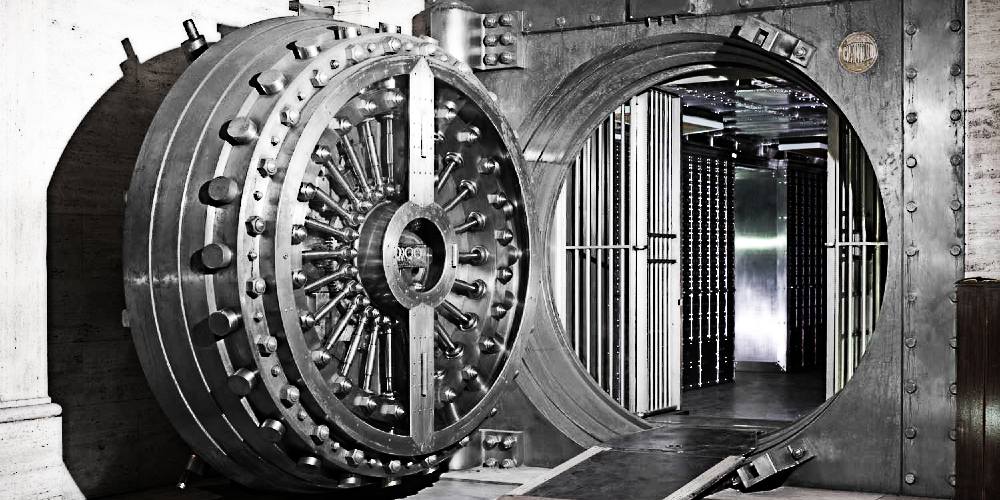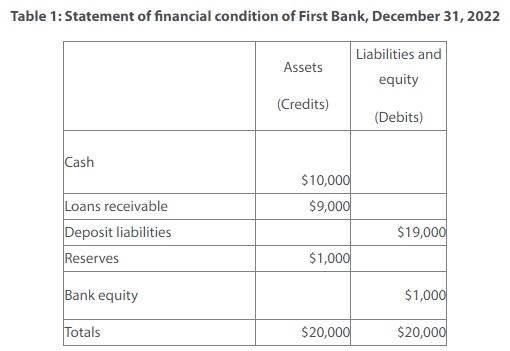You might rightfully wonder: How can a bank, like the neighborhood bank down the street, “create money out of thin air”?
To answer that question, we must enter the magical kingdom of “fractional-reserve banking,” where deposits are turned into loans, loans are turned into money, and so on. For every old dollar that goes in, nine new dollars come out, created with the stroke of a pen or the click of a mouse. As you may be aware, general deposits are loans by the bank depositor to the bank. However, banks can spin new loans out of old loans, creating a wheel of fortune by lending the same dollar to nine different customers—a feat that, to the uninitiated, is equally quite amazing and frightening!
This financial alchemy is perfectly legal and is in fact carried out with the aid and assistance of central banks everywhere, including our own Federal Reserve. If this wheel of fortune should hit a bump in the road and suddenly fall off its axle, causing the bank to crash, don’t worry because a central bank can do what no one else can legally do: counterfeit new money to set things right, a feat that “all the king’s horses and all the king’s men” cannot do!
Let’s take a closer look at how fractional-reserve banking works. Customer A deposits $10,000 in a checking account at First Bank. First Bank records the cash in its books and credits customer A’s account. The cash is an asset of the bank (a credit), which is offset by the liability to customer A (a debit). First Bank now has cash to lend, subject to government reserve requirements. Reserve requirements, which are established by the Fed, specify the amount (expressed as a percentage of deposits) that a lending institution must hold in reserve, either as vault cash or on deposit with a Federal Reserve bank, in order to guarantee payment of customers’ deposits. The reserve requirement for “reservable” deposits greater than $36.1 million (as of January 3, 2023) at any lending institution has been traditionally 10 percent. As a result, First Bank is free to lend $9,000 of the deposited money, keeping $1,000 in reserve.
Customer B comes into First Bank seeking a car loan. First Bank agrees to lend customer B $9,000. First Bank credits customer B’s checking account for $9,000 and debits an asset account called “loans receivable.” As you will recall, bank loans to customers are “investments” and, therefore, are assets—not liabilities.
At the completion of these two transactions, First Bank’s statement of financial condition would look like this (for simplicity, I have assumed no other transactions).
Notice that the bank has deposit liabilities of $19,000 and cash on hand of $10,000. Let’s assume that the loan to customer B is for three years, payable with interest in monthly installments. The demand deposits (checking account balances) include the original deposit of $10,000 from customer A plus the proceeds of the loan to customer B of $9,000. Presumably, customer B will spend the loan money on a car in the next few days. Where did the loan money credited to customer B’s checking account come from? Out of thin air!
The wheel turns again when the car dealer deposits the $9,000 proceeds in his bank, Second Bank. Now Second Bank, like First Bank, is free to make loans, subject to the 10 percent reserve requirement. When the wheel finally stops turning, loans of $90,000 have been created on a cash base of just $10,000. As we have seen, that cash is itself a chimera—nothing more than debt wrapped inside more debt.
The table above demonstrates that banks can expand the money supply by a factor of ten when the reserve requirement is 10 percent. Historically, the United States reserve requirement has been 10 percent on transaction deposits, such as checking and negotiable order of withdrawal accounts (M1) deposits, and 0 percent on time deposits, such as deposits into savings accounts and certificates of deposit. The 0 percent reserve requirement on time deposits enables banks to expand the money supply by more than a factor of ten.
Some would argue that banks are not really “insolvent,” just at times illiquid—not always having ready cash when needed. However, that’s true only if we consider just one or a few banks at a time. Any bank having a temporary shortage of cash could always borrow the needed funds to make up for the temporary cash shortage. The problem, however, is that all banks are illiquid and, when pricked by some general financial shock, can easily slip into insolvency.
When the reserve ratio is 10 percent, total deposits are reduced by ten dollars for every dollar withdrawn from the banking system. Banks then have to call in loans or sell securities to cover their depositor’s demands for money. This “liquidity crisis” is the reason behind most financial “panics,” bank runs, and similar economic disturbances. It’s “debt on the way down,” but this time on a grand scale!
Effective March 26, 2020, the Federal Reserve reduced bank reserve requirements, get this, to zero! Even prior to this change, reserve requirements only applied to transaction accounts, nonpersonal time deposits, and Eurocurrency liabilities. Everything else was “jokers are wild.” Thus, banks could create as much funny money as the traffic would bear. When reserve requirements are zero, the ability to create money is infinite!
The Fed’s money manipulation is the root cause of our economic problems. Bubbles in housing prices, United States Treasury notes and bonds, and cryptocurrencies—to give but a few examples—and the recent failures of the Silicon Valley, Republic, and Signature banks can all be traced to our monetary policies.
The fundamental issue for most banks is that they are forced to invest “long” but borrow “short,” something no prudent finance manager would ever do. Checking and other demand deposits are short-term liabilities of the bank. Bank loans, such as car loans, are intermediate-term investments. Mortgage loans are long-term investments. Banks also invest in government securities to balance their investment loan portfolio. Investing “long,” however, subjects the bank to interest-rate risks because the value of their investment loan portfolio is inversely related to changes in interest rates. A thirty-year mortgage loan yielding 2 percent is only worth a fraction of a similar loan yielding 6 percent. To be more precise, a $100,000 investment in such an instrument would be worth only $44,280 if interest rates were to rise to 6 percent. If interest rates rise to 8 percent, the value would fall to $31,768, according to the bond price calculator.
Therein lies the trap that Silicon Valley Bank (SVB) fell into—with disastrous results. It’s the trap set by the very nature of fractional-reserve banking:
Over a period of just two days in March 2023, the bank went from solvent to broke as depositors rushed to SVB to withdraw their funds, resulting in federal regulators closing the bank for good on March 10, 2023.
SVB’s collapse marked the second largest bank failure in U.S. history after Washington Mutual’s in 2008.
That money created out of thin air should one day evaporate before our eyes should surprise no one, except perhaps Paul Krugman and his fellow court jesters at the New York Times. The endless cycles of boom and bust are a direct result of government manipulation of the money supply. It’s really that profound and that simple.
About the Author
Stephen Apolito is a CPA living in Bronxville, New York. A veteran of the US Air Force, Apolito is a graduate of Washington and Lee University and has taught in the New York City public schools.
Article cross-posted from Mises.







